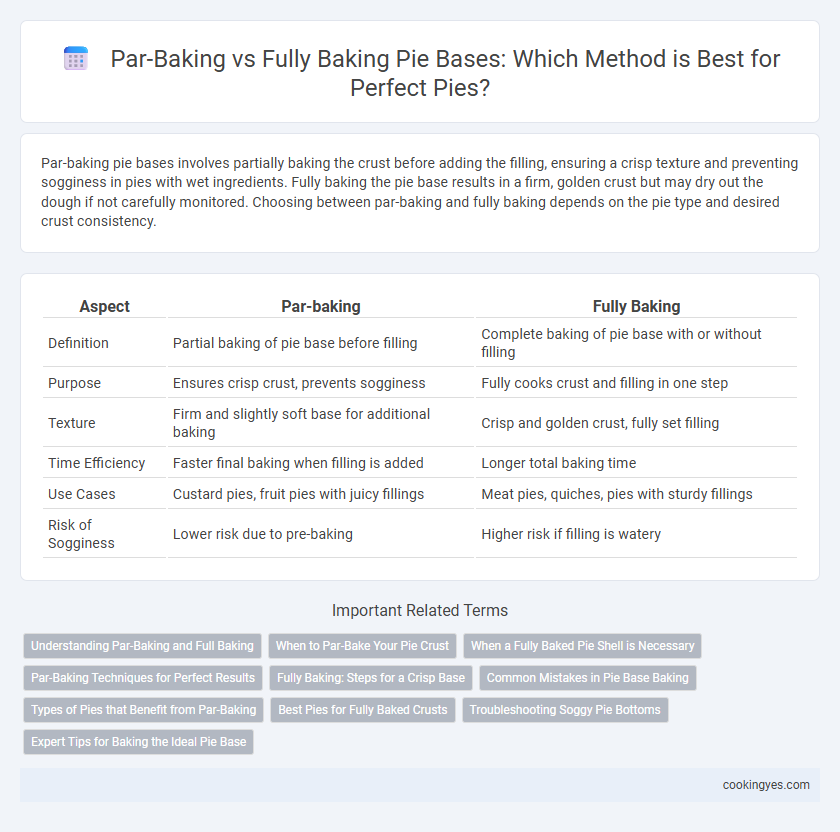Par-baking pie bases involves partially baking the crust before adding the filling, ensuring a crisp texture and preventing sogginess in pies with wet ingredients. Fully baking the pie base results in a firm, golden crust but may dry out the dough if not carefully monitored. Choosing between par-baking and fully baking depends on the pie type and desired crust consistency.
Table of Comparison
| Aspect | Par-baking | Fully Baking |
|---|---|---|
| Definition | Partial baking of pie base before filling | Complete baking of pie base with or without filling |
| Purpose | Ensures crisp crust, prevents sogginess | Fully cooks crust and filling in one step |
| Texture | Firm and slightly soft base for additional baking | Crisp and golden crust, fully set filling |
| Time Efficiency | Faster final baking when filling is added | Longer total baking time |
| Use Cases | Custard pies, fruit pies with juicy fillings | Meat pies, quiches, pies with sturdy fillings |
| Risk of Sogginess | Lower risk due to pre-baking | Higher risk if filling is watery |
Understanding Par-Baking and Full Baking
Par-baking pie bases involves partially baking the crust to set its structure, preventing a soggy bottom when filled with wet ingredients. Fully baking, or blind baking, cooks the crust completely, ensuring a golden, crisp texture ideal for pies with fillings that don't require further baking. Understanding the differences helps in selecting the right technique based on pie type and desired crust consistency.
When to Par-Bake Your Pie Crust
Par-baking pie crusts is essential when recipes include wet fillings, like custards or fruit, preventing sogginess by creating a firm, partially baked base. Fully baking is ideal for dry fillings or when the crust needs to be a standalone snack. Knowing when to par-bake extends the crust's texture and flavor, ensuring a crisp, golden foundation for your pie.
When a Fully Baked Pie Shell is Necessary
A fully baked pie shell is necessary when the filling requires no further baking or when it is pre-cooked, such as in cream pies or custard-based desserts. This method ensures a crisp, golden crust that prevents sogginess caused by liquid fillings. Par-baking, by contrast, suits fillings that bake alongside the crust, providing a partially set shell that finishes cooking during the filling's baking process.
Par-Baking Techniques for Perfect Results
Par-baking pie bases involves partially baking the crust to set its structure and prevent sogginess when adding moist fillings. Techniques such as blind baking with pie weights ensure an even bake and a crisp texture, crucial for custard or fruit pies. Achieving the right par-baking time and temperature, typically around 375degF (190degC) for 15-20 minutes, results in a sturdy, flaky crust ready for final baking or filling.
Fully Baking: Steps for a Crisp Base
Fully baking pie bases ensures a crisp, golden crust ideal for both sweet and savory pies by thoroughly cooking the dough and preventing sogginess. Begin by blind baking the crust with pie weights to maintain shape, then bake at a high temperature--typically 375degF to 425degF--for 15-20 minutes until the edges turn golden. Allow the base to cool completely before adding fillings to preserve its crispness and avoid moisture absorption.
Common Mistakes in Pie Base Baking
Common mistakes in pie base baking include underbaking during par-baking, which can lead to a soggy crust that fails to support fillings properly. Fully baking without allowing steam to escape often causes bubbling and uneven texture in the pie base. Using incorrect oven temperatures and neglecting to dock the dough further contribute to inconsistent results in both par-baking and fully baking pie crusts.
Types of Pies that Benefit from Par-Baking
Par-baking, or partially baking pie crusts, is ideal for custard pies, fruit pies with high-moisture fillings, and cream pies, where a fully baked crust prevents sogginess. Fully baking pie bases suits pies with dense, pre-cooked fillings like pecan or pumpkin, ensuring a crisp, stable foundation. Using par-baking selectively enhances texture and prevents the crust from becoming overly browned or undercooked during final baking.
Best Pies for Fully Baked Crusts
Fully baked pie crusts are ideal for custard, cream, and fruit pies with wet fillings, ensuring a crisp and sturdy base that prevents sogginess. Pies like pumpkin, pecan, and chocolate silk benefit from fully baked crusts as they maintain texture and flavor integrity during chilling or baking. This method enhances the overall pie quality by creating a golden, flaky crust that supports rich, moist fillings without compromising structure.
Troubleshooting Soggy Pie Bottoms
Par-baking pie bases creates a partially baked crust that helps prevent sogginess by forming a moisture barrier, essential for fruit or custard fillings with high water content. Fully baking the pie base before adding filling ensures a crisp and well-cooked bottom but risks over-browning if not monitored closely. To troubleshoot soggy pie bottoms, improve heat distribution by using a preheated baking stone or blind baking with pie weights, and choose recipes that balance filling moisture with crust thickness.
Expert Tips for Baking the Ideal Pie Base
Par-baking pie bases partially cooks the crust, creating a barrier that prevents sogginess from wet fillings, ideal for cream or custard pies. Fully baking ensures a golden, crisp texture suitable for fruit pies with juicy fillings, enhancing flavor and structural integrity. Experts recommend using pie weights during par-baking to maintain shape and prevent bubbling, achieving a professional-quality pie base every time.
Par-baking vs Fully baking for pie bases Infographic

 cookingyes.com
cookingyes.com